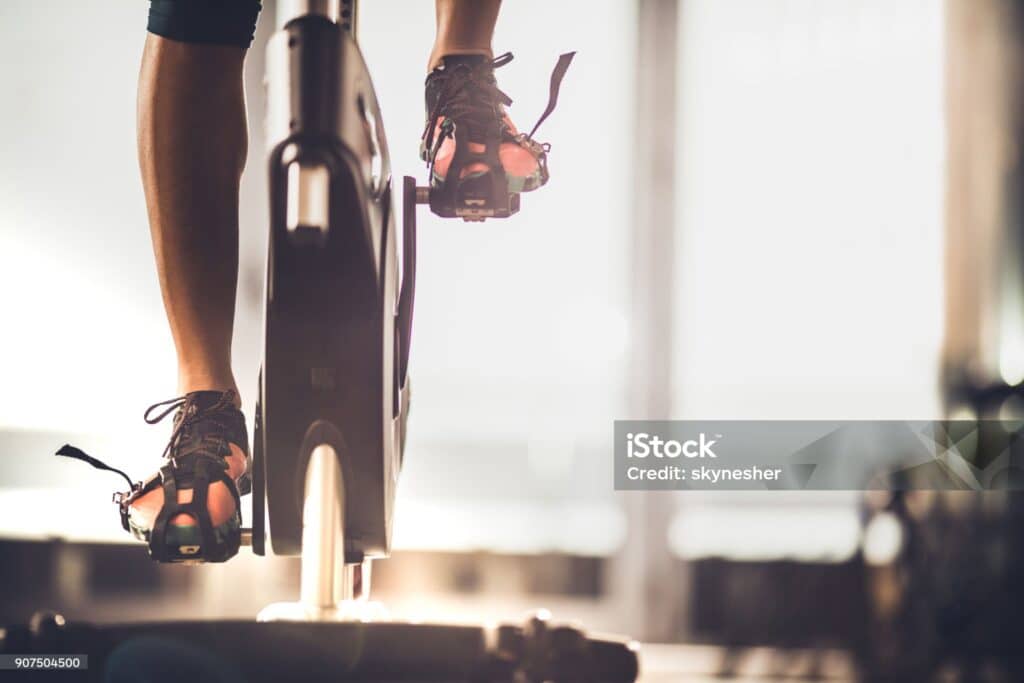
Summary
Welcome » Welcome » Tips for getting started » Stationary Bike Hiit Program: Burn Calories and Boost Your Endurance
Stationary Bike Hiit Program: Burn Calories and Boost Your Endurance
Vous cherchez un moyen efficace de brûler des calories, de renforcer votre cœur et d’améliorer votre condition physique rapidement ? Le HIIT sur vélo stationnaire est la solution idéale. Ce type d’entraînement, basé sur des intervalles d’effort intense, offre des résultats rapides sans nécessiter de longues séances. Profitez des bienfaits du vélo mélangés au HIIT.
Summary
What is HIIT?
In this article, you will discover programs adapted to all levels, from beginner to experienced cyclist. You will also learn how to optimize your sessions to progress quickly.
High-Intensity Interval Training, better known by the acronym HIIT, is a training method that combines periods of intense effort with short recovery phases. This type of training is particularly appreciated for its effectiveness in improving physical condition in a minimum of time. Unlike classic endurance sessions, where the intensity remains moderate and constant, HIIT plays on the alternation between peaks of effort where the body is pushed to its limits, and periods of active recovery, allowing the body to prepare for the next effort.
Benefits of HIIT over traditional training
HIIT has several advantages over more traditional training methods. First, it allows you to burn more calories in less time. The high intensity of the sessions pushes the body to use a significant amount of energy not only during exercise, but also afterwards, thanks to the so-called “afterburn” effect (or EPOC, for Excess Post-exercise Oxygen Consumption). This effect makes your body continue to burn calories even after the workout is over.
In addition, HIIT is particularly effective for improving cardiovascular capacity. By challenging the heart and lungs at a high level, it helps strengthen the cardiovascular system faster than traditional endurance training. It is an ideal choice for those with a tight schedule, as HIIT sessions are short but very intense, making them accessible even with a busy schedule.
Why the Stationary Bike is Great for HIIT
The stationary bike is ideal for HIIT for several reasons. First, it allows for precise control over the intensity of the effort. You can adjust the resistance of the bike according to your fitness level and goals, which makes it a versatile tool. In addition, the stationary bike reduces the risk of injury compared to other forms of high-intensity exercise like running, because it limits the impact on the joints.
Finally, the stationary bike allows you to focus entirely on the effort without worrying about the external environment, such as traffic or weather conditions. You can thus fully immerse yourself in your session, maximize your performance and fully enjoy the benefits of HIIT.
The benefits of HIIT on a stationary bike
HIIT on a stationary bike is an incredibly beneficial training method for those who want to optimize their time while achieving significant results. This type of training combines the effectiveness of HIIT with the unique benefits of the stationary bike, thus offering a winning cocktail to improve your fitness quickly and effectively.
Rapid improvement in physical condition
One of the main benefits of HIIT on a stationary bike is its rapid impact on fitness. By alternating between periods of intense effort and recovery, your body is constantly challenged. This intense use of muscles and the cardiovascular system promotes rapid adaptation, meaning you will see noticeable improvements in endurance and lung capacity in a short period of time. For those looking to get back in shape or increase their performance, HIIT on a stationary bike is a quick and effective solution.
Effective calorie burning
If your goal is weight loss, HIIT on a stationary bike is a great ally. The short but intense sessions promote significant calorie burning not only during training, but also afterwards thanks to the afterburn effect. This effect, known as EPOC, allows you to continue burning calories even at rest. In addition, the stationary bike, by engaging the large muscle groups of the legs and glutes, contributes to high energy expenditure, thus maximizing the effectiveness of every minute spent training.
Save time compared to long sessions
HIIT on a stationary bike is particularly suitable for those with busy schedules. Sessions can be completed in 20 to 30 minutes, while providing comparable or even greater benefits than longer endurance sessions. This time saving is a huge advantage for incorporating physical activity into a daily routine without sacrificing results. In other words, you get more done in less time, which is ideal for active and dynamic people.
Cardiovascular strengthening
HIIT on a stationary bike is also exceptional for strengthening the cardiovascular system. Each session pushes your heart to work at a high intensity, which gradually improves its ability to pump blood and oxygenate your muscles. This translates into better endurance, a reduced risk of cardiovascular disease, and better overall health. For those looking to boost their heart health while still being efficient in their workout, HIIT on a stationary bike offers a comprehensive and targeted approach.

Basics of a HIIT Program on a Stationary Bike
To get the most out of your HIIT workouts on a stationary bike, it’s essential to understand the basic principles behind this type of training. A well-structured HIIT program is based on a balanced combination of different elements, maximizing effectiveness while minimizing the risk of injury.
Structure of a HIIT session
A HIIT session on a stationary bike is divided into three main phases: warm-up, high-intensity intervals alternating with recovery phases, and cool-down.
Warming up
Warming up is a crucial step that prepares your body for the intense effort to come. It usually consists of 5 to 10 minutes of pedaling at a moderate intensity. This phase allows you to gradually increase your heart rate, stimulate blood flow to your muscles and reduce the risk of injury.
Alternation of intense intervals and recovery
At the heart of HIIT is the alternation between intense effort intervals and recovery periods. Typically, intense intervals last from 20 seconds to a minute, during which you pedal at maximum intensity. These effort phases are followed by active recovery periods, where the intensity is reduced to allow the body to recover while maintaining physical activity. The number of intervals and their duration will vary depending on your fitness level and goals.
Return to calm
The cool-down is just as important as the warm-up. It allows the body to gradually return to a resting state. This usually involves 5 to 10 minutes of low-intensity pedaling, helping to gradually reduce the heart rate and promote muscle recovery. Neglecting this step can prolong the post-session recovery time.
Parameters to consider
The success of a HIIT program on bike stationary depends on several key parameters. By adjusting them to your needs, you can customize your workout to be both effective and safe.
Duration of intervals
Interval duration is one of the most important factors to consider. For beginners, shorter intervals (20 to 30 seconds) are recommended, while more experienced cyclists can increase the duration of intense intervals up to one minute. It is crucial to choose durations that allow you to maintain maximum intensity throughout the interval.
Intensity of efforts
Intensity is at the heart of HIIT. Each interval should be performed at an intensity that pushes you to your limits. Use the resistance of the stationary bike to adjust the difficulty and make sure your heart rate reaches a high work zone (around 80-90% of your maximum heart rate). However, listen to your body and adjust the intensity if necessary to avoid overtraining.
Effort/recovery ratio
The ratio of effort to recovery plays a big role in how you structure your workout. A typical ratio for beginners is 1:2 (e.g., 30 seconds of effort to 60 seconds of recovery). As you progress, you can move to a 1:1 ratio, or even reverse the ratio for an even more intense workout.
Frequency of sessions per week
Finally, the frequency of the sessions is another parameter to consider. To start, 2 to 3 HIIT sessions per week are enough to see significant results. Over time, you can increase the frequency, but it is crucial to ensure that your body has enough time to recover between sessions. Overtraining can lead to injuries and reduce the overall effectiveness of your program.
Stationary Bike HIIT Programs Suitable for Beginners
Getting started with HIIT on a stationary bike can seem daunting, especially for beginners. However, by starting with programs that are tailored to your level, you can gradually build your endurance and strength while enjoying the many benefits of this workout. Here’s a guide to help you get started gently and progress at your own pace.
2-week beginner program
The program I am offering you is designed to gradually introduce you to the demands of HIIT on a stationary bike. Over two weeks, you will gradually increase the intensity and duration of the intervals, while respecting your initial fitness level.
Session 1: 10 minutes with 20 second intervals
Start with a 10-minute session, where you will alternate 20 seconds of intense effort with 40 seconds of recovery. This short interval is ideal for familiarizing yourself with the concept of HIIT without exhausting your resources from the first session. Don't forget to warm up well for 5 minutes before starting, and to finish with a 5-minute cool-down.
Session 2: 15 minutes with 30 second intervals
For the second session, you will slightly increase the duration of the effort intervals to 30 seconds, while reducing the recovery time to 30 seconds as well. This 15-minute session will allow you to start developing your endurance while continuing to work at a high intensity. Again, a good warm-up and cool-down are essential to avoid injury and promote recovery.
Progression over 2 weeks
Over the course of the two weeks, you'll repeat these sessions, gradually increasing the total duration of the workout and the intensity of the intervals. For example, you might add an extra 5 minutes to each session at the beginning of the second week, while keeping the same effort and recovery ratios. The goal is to get your body used to the effort while still listening to how you feel.
Tips for getting started
When you're new to HIIT on a stationary bike, it's important to follow a few tips to maximize your results while avoiding common mistakes.
Importance of gradual warm-up
A gradual warm-up is essential to prepare your body for the intense effort that follows. Spend 5 to 10 minutes pedaling gently, gradually increasing the intensity to activate the muscles and cardiovascular system. A good warm-up not only reduces the risk of injury, but also improves your performance during intervals.
Listening to your body and adapting the intensity
It’s crucial to listen to your body, especially as a beginner. If you feel unusual pain or are excessively out of breath, don’t hesitate to reduce the intensity or lengthen the recovery periods. HIIT is demanding, but it should stay within the limits of what your body can handle.
Hydration during the session
Don’t forget to hydrate regularly during your sessions. HIIT causes you to sweat a lot, and proper hydration is essential to maintain your performance and avoid cramping or exhaustion. Always have a bottle of water on hand and take small sips throughout your workout.
Intermediate HIIT Programs for Stationary Bike
Once you’ve gained some experience with HIIT on a stationary bike, it’s time to move on to an intermediate level. These programs are designed to intensify your workouts, improve your fitness, and continue to progress toward your goals. Intermediate sessions require more endurance and power, but they’re still accessible with a good training base.
4-week program to progress
This four-week program is designed to help you take your performance and endurance to the next level. It combines intervals of varying lengths to challenge the body in a varied and effective way.
Week 1-2: 30/30 second intervals
For the first two weeks, the goal is to work on a 30/30 second effort-recovery ratio. After a 10-minute warm-up, alternate 30 seconds of intense effort with 30 seconds of active recovery. Repeat this interval for 20 minutes. This ratio allows you to maintain a high intensity while benefiting from sufficient recovery to properly execute each interval.
Week 3-4: 40/20 second intervals
For the final two weeks, you'll switch to intervals of 40 seconds of effort followed by 20 seconds of recovery. This modification increases the difficulty because you're spending more time at high intensity with less recovery. This phase is designed to push your body to adapt to prolonged efforts and shorter recoveries, increasing your aerobic and anaerobic capacity.
Example of a detailed session
Here is an example of a typical session for week 3:
- Warming up : 10 minutes of pedaling at moderate intensity.
- HIIT session :
- 40 seconds of maximum intensity effort
- 20 seconds of active recovery
- Repeat this interval 10 to 12 times
- Return to calm : 5 to 10 minutes of light pedaling to recover.
This session, although intense, is designed to push you to your limits while allowing you to develop high intensity endurance.
Variations to diversify training
To avoid monotony and continue to stimulate your muscles, it is crucial to vary your sessions. Here are some variations to integrate into your program.
Pyramid HIIT
Pyramid HIIT is an approach where the duration of intervals gradually increases to a peak and then decreases. For example, you might start with 20 seconds of effort, then increase to 30, 40, and 50 seconds, before returning to 40, 30, and 20 seconds. This method stresses your muscles and cardiovascular system differently, while maintaining interest and motivation.
Tabata on bike
The Tabata protocol is a form of ultra-intense HIIT, consisting of 20 seconds of maximum intensity effort followed by only 10 seconds of recovery, repeated for 4 minutes. This format is ideal for days when you are short on time, but still want an effective session. Be careful, this type of session is demanding and is best suited to practitioners who already have a good training base.
Progressive intervals
Progressive intervals involve increasing the intensity or resistance with each round of exercise. For example, you might start with a light resistance for the first interval and then gradually increase it with each new set. This method helps build your ability to maintain effort despite accumulating fatigue, which is especially beneficial for improving overall performance.
Advanced HIIT programs for experienced cyclists
For advanced cyclists, HIIT on a stationary bike becomes an indispensable tool for pushing the limits of performance. At this level, programs are designed to maximize power, endurance, and rapid recovery capacity. These intense workouts are not for the faint of heart, but for those looking to reach new heights in their fitness.
6-week high-intensity program
This advanced six-week program is structured to increase the maximum capacity of your muscles and cardiovascular system. It focuses on long, demanding intervals, with limited recovery, to force the body to adapt to extreme conditions.
1 minute intervals at maximum intensity
Each session begins with a warm-up of at least 10 minutes to prepare your muscles for the effort. Then, the main workout consists of 1-minute intervals at maximum intensity, where you push your body to its maximum capacity. These intervals are followed by 30 seconds of active recovery, during which you continue pedaling at a very low intensity.
30 second active recovery
Active recovery between intervals is crucial. It is short, but allows for light muscle activity to clear out metabolic waste produced during exercise. The goal is to prepare your body to attack the next interval with as much force as the previous one. This training method is extremely demanding and requires rigorous discipline.
Progression in duration and intensity
As the weeks go by, you'll increase the number of reps and the intensity of the intervals. For example, the first two weeks might focus on 6-8 reps, while weeks 3 and 4 increase to 10 reps, and weeks 5 and 6 go up to 12 reps. The goal is to push your limits progressively while allowing for muscular and cardiovascular adaptation.
Extreme HIIT Challenges
For serious cyclists looking for an extra challenge, here are some extreme HIIT formats that will test even the most experienced.
“Death by HIIT” adapted to cycling
This challenge involves performing one minute of maximum effort followed by one minute of active recovery, adding an additional minute of effort to each subsequent interval. For example, after the first minute of effort, the second session will consist of two minutes of effort, then three, and so on, until you can no longer maintain the intensity. It's the ultimate test of your mental and physical endurance.
The 1000 Calorie Challenge
For the more adventurous, the 1000 calorie challenge consists of burning 1000 calories in a single HIIT session. This challenge is reserved for those who are in excellent physical condition, as it requires not only endurance but also the ability to maintain a high intensity for a long time. It requires careful preparation, adequate hydration and rigorous post-session recovery.

Conclusion
HIIT on a stationary bike is a fast and effective way to improve your fitness, burn calories and strengthen your cardiovascular system. Whether you are a beginner, intermediate or advanced, tailored programs allow you to progress at your own pace. Optimize your sessions by adjusting the bike settings, tracking your performance, and recovering effectively.
Go indoor cycling with Space Cycle
Want to combine cycling and strength training? At SPACE CYCLE, our POWER RIDE session combines cardio and muscle strengthening for a complete workout focused on the “core”.
Dive into an immersive experience at SPACE CYCLE, where lighting effects and a dynamic atmosphere, hosted by our coaches and their exclusive playlists, await you.
Join us in our Bonne Nouvelle or Bastille studios for unique indoor cycling classes!
Read also
RPM combien de fois par semaine : Guide pour optimiser vos séances
Vélo d’appartement bienfaits : pourquoi l’adopter dès maintenant ?
Follow us
on instagram
To follow all our news,
take advantage of our tutorials and participate
in our many contests.
Breaking news!
Receive our newsletter.





